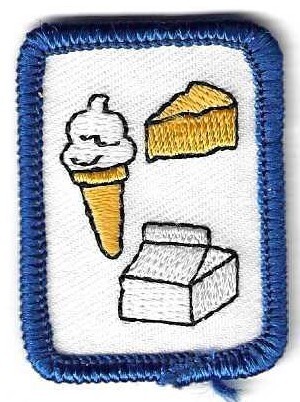Milkey Whey, Great Blue Heron Council own IP (Original?)
Requirements:
The Milky Whey Interest Patch: Developed By: LaVonne Ellenbecker – Glacier Hills Service Unit, Great Blue Heron Council, Inc., Wisconsin and now supported by Service Unit #1, Riverland Council, La Crosse,
Girls are to complete two activities in the Skill Builders section, one activity from each of the other three sections, and two activities of their own choosing.
Skill Builders:
1. Visit a dairy farm complex and learn about the dairy/milking process.
2. Find out how dairy cows came to Wisconsin. How did the colonists use dairy cows to survive?
3. Learn what “animal husbandry” is. How does it relate to dairy farming?
4. What is the Food & Drug Administration? How does it affect dairy farming?
5. Discover who Louis Pasteur was and how he contributed to the production of milk.
6. Make a time line of milk, chart and display it where others can see it. (Started hundreds of years ago with buckets – changed to metal containers, to glass jars (delivered to homes), cardboard, and now plastic containers).
7. Chart the life cycle of a dairy cow and the differences of each stage. Label your drawings with the main body parts of a Dairy Cow; show the different stages of development (newborn, 6 months, yearling, 2 years, mature).
8. Research the dietary needs your body requires. Why are dairy products important to maintain a healthy body? What are the recommended daily servings of dairy products per day to stay healthy?
Technology:
- Attend a Farm Technology Day to learn about new technologies used in dairy farming.
- Visit a modern farm and see how they use technology to improve milk collection and milk production.
- Make your own Curds & Whey OR natural “plastic” from dairy products OR Milk Glue (See resources for directions)
Find out about the feeding process of Dairy Cattle. What different types of plants are used for feeding? What food supplements are needed to provide a proper diet for the cattle? Is there more than one method of planting crops used for feeding dairy cattle? How does a dairy farmer decide what is the correct type of feed for their cattle? What type of pest control is used for helping dairy cows to be comfortable and healthy? How do the pest controls affect the people applying it? Does it have an affect on the milk production? Why is pest control necessary to maintain a healthy Dairy Cow? What is the effect on people eating or drinking the milk product?
Career Exploration:
1. Invite a dairy farmer to your troop to discuss their career. Ask questions about pros and cons of being a dairy farmer.
2. What would you need to do to start a Dairy Farm? Research the steps in becoming a Dairy Farmer? (buy land, research type of dairy cattle, what type of crops would you need to plant? What equipment would you need?)
3. Design the pictures and layout for the cover of a magazine promoting dairy farming. What articles would you include in your magazine? What cover story would create an eye-catching story?
4. Design a dairy farm layout and field irrigation system. Display it where others can see it (County Fair, etc)
5. Interview a Dairy Farmer; ask questions about their job, why they picked dairy farming? What are the most important things about dairy farming? What kind of foods do they need to feed dairy cows? OR Visit a County Fair or State Fair and interview a student who is showing a dairy cow. Find out why they decided on showing a dairy cattle and what is involved in preparing for a competition on the fair grounds. Take pictures (if possible). Write your interview as a news report and share it with your troop (or submit it to your school or local newspaper for publishing.
6. Take the Dairy Career Quiz and find out what aspect of Dairy Farming and Production you would be good at. Put together a short presentation (or play) for your Girl Scout Troop demonstrating the part of dairy farming or production you choose.
Service Projects:
1. Volunteer to help work at a dairy farm. Learn how to milk the cows. OR volunteer to work at a Dairy Complex (some Zoo’s have Dairy Complex’s) OR volunteer to help at a local Humane Society. (Discover if they have a large animal rescue program and what is involved).
2. Bake dairy products and distribute to local Nursing Homes as “care packages” OR run a cheese tasting party for a sister troop.
3. Help local food pantries to collect, distribute and stock milk & cheese products OR run a food drive for dairy products to be distributed to children in need.
4. Collect recycled dairy products (example: milk containers) and create a recycle display at a local event to promote recycling. (Example: County or State Fair, Milwaukee County Zoo, etc)
5. Create an information pamphlet about dairy products or dairy farming to distribute to younger Girl Scouts: Include information on calcium needs, dairy farming, daily nutritional needs, and dairy products. (could be distributed at Girl Scout booths at fairs, etc)
6. Help teach a Brownie Girl Scout Troop (or Junior Girl Scout Troop) about proper dairy calcium needs for their bodies, the food pyramid, milk production, etc. (You could use your developed brochure from step #5 as part of your presentation). ** You could use the Cow Facts Quiz as a starting point to your lesson. ** (See resources).
7. Run a program for Brownies/Juniors to earn Dairy Delights Try-It or Got Milk Badge
